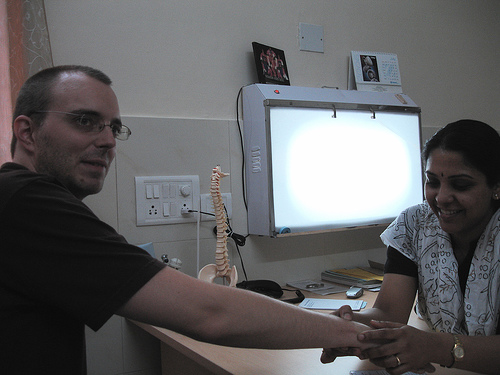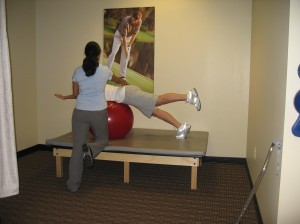by Michelle Sutton-Kerchner
Over 50 million Americans undergo surgery each year. Fifty percent of the outcome depends on the surgeon’s skills. The other 50 percent – you determine …
Prior to undergoing surgery, most thoroughly investigate their options. Surgeons, hospitals, and specifics on the procedure are researched. Post-surgery recovery and rehabilitation hint at what to expect. To further assure success, a pre-habilitation program is also essential.

A patient’s commitment to recover, even before surgery takes place, is a large factor in a successful recovery, according to Vonda Wright, MD, assistant professor of orthopedic surgery at the University of Pittsburgh’s Center for Sports Medicine.
Getting in Pre-surgery Shape
The healthier you are going into surgery, the quicker and easier your recovery will be. Don’t stress your body with an overzealous jump into a fitness routine. Follow some simple guidelines:
- Begin pre-hab at least six weeks prior to your surgery.
- If you’re new to exercise, start slowly. Now is not the time to exacerbate any other conditions or pull a major muscle.
- If you’re an exercise buff, consider increasing your workout’s intensity, duration, or frequency. Prep your body for this upcoming challenge. Be sure this won’t interfere with your injury or condition though.
- Consider joining a Yoga class. This can help prepare your mind and body for surgery through relaxation techniques and soothing movements. (Check the Center’s Web site to find a Yoga class on the Group Fitness schedule that’s convenient for you.)
Medical studies conducted out of Boston focused on knee- and hip-replacement surgery patients who participated in six weeks of pre-surgery workouts. The sessions included aquatic and land-based strength training, and aerobic and flexibility exercises. These participants reduced their chances of needing in-patient rehabilitation by an incredible 73 percent.
If you don’t have the luxury of time, small steps can make a difference. Even a few days of gentle stretching and healthy meals prior to the procedure can increase your fortitude.
Daniel Rooks, PhD, assistant professor of medicine at Harvard Medical School, notes a pre-hab program increases functioning and decreases pain so you can undergo surgery in optimum shape. “The benefits of exercise before surgery are very clear: The more you can do for yourself physically before surgery, the better off you will be,” he attests.
Go Home Quicker
Hospital food has come a long way. And, some might enjoy the attention and chance to rest. However, we aren’t talking about a 5-star hotel in a glamorous resort. Most are anxious to trade in that drafty hospital gown for their own PJs. And, although the hospital beds rival that of the Craftmatic Adjustables (“as seen on TV”), nothing feels as good as one’s own bed.
Increased strength and stamina will help your body immediately after surgery. Translated: You can hit your pillow at home sooner! Heck, you may even feel up for some walking and mild physical activity. After all, you’ve been working out.
Often, there are requirements you need to accomplish before a hospital or surgical center will discharge you. These may include walking a certain length, ascending/descending two or more stairs, and independently using the bathroom. Those goals are more quickly reached by patients who participated in strengthening through a pre-hab program. This means shorter hospital stays.
Patients who pre-habbed typically need less supervised physical therapy. This allows the option for out-patient, post-surgery rehab, rather than residence at an in-patient rehabilitation facility. They can follow up more on an as-needed basis. This independence is uplifting and promising for those in recovery, when a positive outlook is critical for healing.
Many physicians are now “prescribing” pre-hab before surgery. Those patients are on their feet sooner, require less intervention from healthcare practitioners, and make an overall quicker recovery. Unfortunately, health insurance does not often specifically cover pre-hab sessions. Or, they combine them with post-rehab for a total of only so many weeks.
The Center connects you with sources to create your own valuable pre-hab program. Contact a personal trainer who can help you create a customized pre-surgery workout routine. S/he can help you focus on areas that will be specifically affected by your surgery.
This may be an ideal time to incorporate aquatic workouts into your routine, if you don’t already. The buoyancy and gentleness of the warm water will ease movement for the post-surgery body. Learn the best exercises prior to your surgery so you’re ready to begin without start-up troubleshooting.

Take advantage of the Center’s on-site physical therapy. As you graduate to the Exercise Floor, your therapist will be readily available to respond to questions and issues that may arise. The nurse can monitor you throughout to confirm your heart rate and blood pressure are within normal limits. As a member, you have extensive resources to assist as you recover from surgery. Such support reduces the trauma associated with surgery, both physical and mental, and allows you to confidently focus on healing.
Suggested Exercises
Here are several simple exercises a physical therapist or personal trainer may include in your pre-surgery routine. Each one focuses on a different area of the body. Ask a personal trainer for a demonstration and any additional suggestions.
- Straight leg raises
- Standing heel raises
- Side leg raises
- Standing hip extensions
- Hamstring stretches
- Shoulder blade squeezes
- Clam stretches
- Bridge stretches

Foods for Healing
More studies are proving that food affects the body’s inflammation and pain levels. Eat right for an easier recovery. Unhealthy fats (trans and saturated) found in processed foods are known to increase inflammation and the pain it causes.
Choose lean cuts of meat, and low-fat cheese and milk. Although these food sources are needed for vitamins and minerals, you can and should watch the quantity and fat percentage of these products.
Avoid the Nightshade Family of Plants. Vegetables from these plants contain a chemical alkaloid called solanine, which may trigger pain in some individuals.
Fruits and veggies are an essential part of a healthy diet. They provide vitamins, minerals, and antioxidants. However, vegetables from this family– such as potatoes, tomatoes, and eggplant—may have an adverse affect on some. Consider it a form of food allergy that may exacerbate existing pain from inflammation.
Formal research has not confirmed this claim, so experiment on your own to determine how/if you react to the Nightshade Family of Plants. Keep a finger on the nutrition pulse; this is a trending topic.
Avoid high-sugar foods. Sodas, candy, pastries, and even some cereals fall under this category. Experts suggest avoiding them altogether. If that sounds too challenging, enjoy in moderation. Gradually, replace these items with naturally sugared foods, like fruit.
Omega-3 essential fatty acids strike again! Add inflammation reduction to their list of beneficial properties. Snack on walnuts, flax seeds, and pumpkin seeds. Eat more cold-water oily fish. Cook with olive oil, rice bran oil, grape seed oil, and walnut oil.
Protein builds healthy body tissue. Enjoy lean poultry, fish and seafood, nuts, legumes, and seeds. Soybeans and tofu are also good protein scores.
Whole grains are an excellent source of fiber, which also reduces inflammation.
Regularly eat dark green vegetables, brightly colored vegetables, and berries. Blueberries and strawberries are especially packed with anti-inflammatory phytochemicals and antioxidants. Fiber will also help with bowel issues that commonly arise from anesthesia.
Pre-hab provides an opportunity to take an active role in surgical care. Rather than complacently waiting, take a pro-active approach. While preparing your body, your mind is kept busy. The stress and nerves provoked by a pending operation are literally worked out.

Approach your surgery date as you would a competition, game, or fitness event. Get yourself in top condition through exercise, diet, and good sleeping habits. More quickly and easily, your body will overcome the challenges that lie ahead. Through a pre-surgery exercise program, you may improve so drastically that surgery becomes unnecessary. Hey, it’s happened.
Sources
“Anti-inflammatory Foods: Can the Foods You Eat Make a Difference in Chronic Pain?” by Shereen Jegtvig at www.about.com.
“Here’s Your Pre-Surgery Workout Plan,” by Dennis Peck at www.orgeonlive.com.
“How to Prepare for Surgery,” by Dixie Mills at www.womentowomen.com.
“Pre-hab for Surgery,” by Terrie Heinrich Rizzo at www.arthritistoday.org.
Image Credits
Back muscles (introductory photo): www.flickr.com/photos/lululemonathletica/4883554529/
Consultation: www.flickr.com/photos/chrisandhilleary/193402547/
Blueberries: www.flickr.com/photos/pinksherbet/321102280
Fitness event: www.flickr.com/photos/lululemonathletica/4883555927
 Fitness & Wellness News Your Source for Fitness News, Wellness News, Health News, and Nutrition News!
Fitness & Wellness News Your Source for Fitness News, Wellness News, Health News, and Nutrition News!




One comment
Pingback: Six Ways to Prepare for Surgery | Total Betty Media